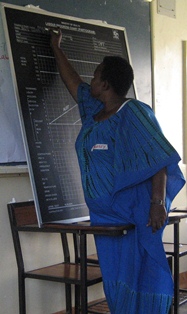
The partograph is a preprinted one-page form on which observations of the progress of labor and information about maternal and fetal condition are recorded. The partograph is designed to act as an “early warning system,” alerting doctors, midwives, and nurses to the need for action, such as referral to a higher level health facility for emergency care or cesarean section. When used correctly, the tool allows health care providers to record, interpret, analyze, and use data to make decisions about labor management. Though the partograph can be vital for preventing maternal mortality and morbidity, it remains an underutilized tool. Since the start of 2012, Fistula Care and partners in Uganda have taken a variety of approaches to promote correct and consistent partograph use.
In February 2012, Fistula Care organized a meeting for 36 participants from around Uganda, including health care providers and government health officers. The meeting attendees exchanged their ideas about the partograph and discussed how to encourage and enable staff to use the tool. Participants acknowledged the challenges to partograph use: Some staff require additional training to use the tool; heavy workloads can impair the use of the partograph; and essential medical equipment, like blood pressure machines, is not always available. Staff from Kitovu Hospital presented about steps they have taken to address these challenges. For instance, a copy of the partograph is automatically included in every Kitovu client’s file, and a special midwife supervises correct partograph use throughout the ward. Meeting participants visited Kitouvu Hospital to observe partograph use at the facility.
In April 2012, Fistula Care staff met with the staff at five facilities around Uganda to continue supporting partograph use. Some hospitals had taken important steps to institutionalize partograph use. One hospital had allocated a special room for sorting and filing maternity records, while another had adopted the policy of keeping a partograph in each client’s folder. Fistula Care plans to continue working with these sites to continue to strengthen partograph use.
Fistula Care also organized a training session at Masaka Referral Hospital. Eighteen health professionals took part in both classroom and practicum sessions. Facilitators guided participants as they practiced monitoring clients and plotting data and observations on the partograph.
Fistula Care partograph activities have generated a renewed sense of interest in the tool in Uganda. Several nursing schools have requested partograph boards—large chalkboards designed to teach partograph use in a classroom setting. Fistula Care supplied the boards to four sites around Uganda, along with an updated guide from the Ministry of Health that explains how to use the partograph.


